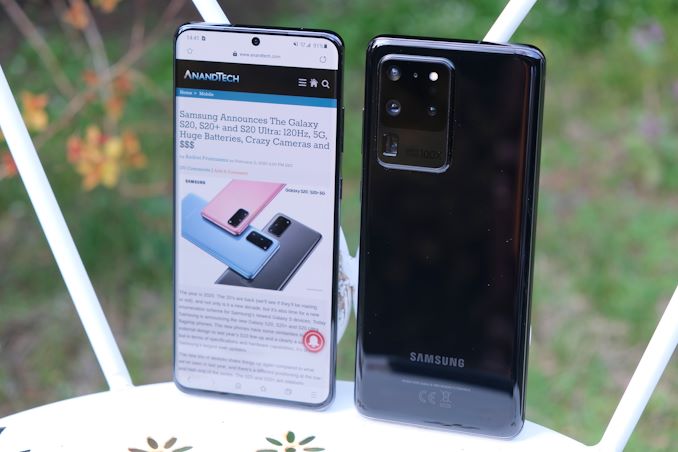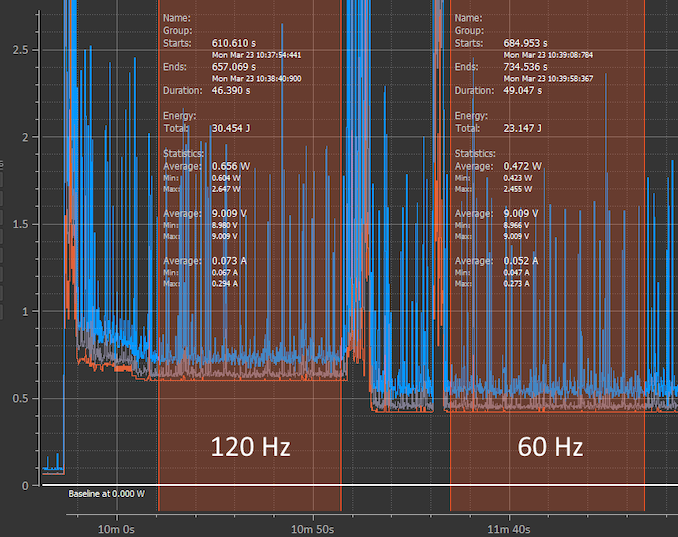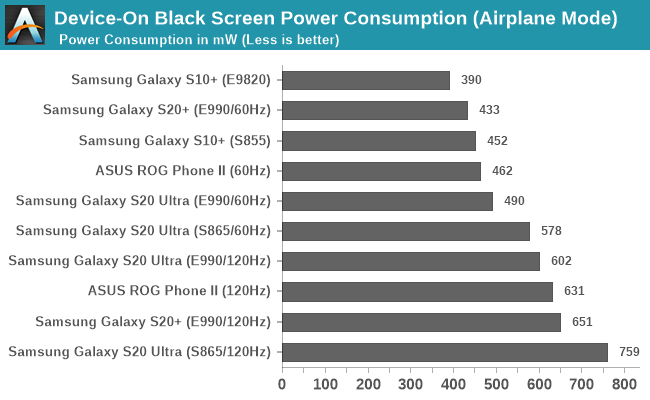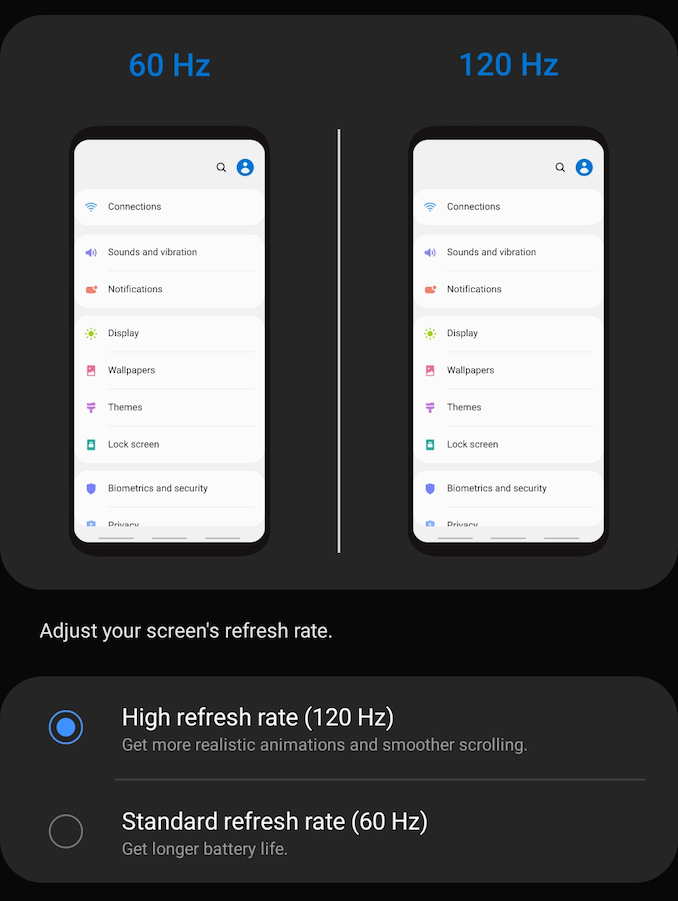Samsung Galaxy S20+ & Ultra (Snapdragon & Exynos) Battery Life Preview
by Andrei Frumusanu on March 23, 2020 8:30 AM EST
This article's data has been superceded by the full review figures here.
Last week we brought you a quick performance preview of the Snapdragon 865-based Samsung Galaxy S20 Ultra, showcasing that the phone has some outstandingly good performance and power efficiency statistics. Since then, we’ve been able to get our hands on an Exynos 990 based Galaxy S20+ and S20 Ultra, putting the trio of phones through our usual extensive review process.
We’re still working on the full big article which is still a week or more away, but we wanted already to cover one largest talking points about the new devices: battery life. Samsung’s new 120Hz refresh mode is quite a power-hungry beast, which alters the battery life formula for this year’s flagships. On top of that, we’re again seeing some quite large differences between the Exynos and Snapdragon based phones, and we’re able to report the first preliminary battery test results and analyse what the situation looks like.
Read More:
-
Samsung Galaxy S20 Ultra (Snapdragon 865) Quick Performance Preview: Impressive
-
The Snapdragon 865 Performance Preview: Setting the Stage for Flagship Android 2020
-
Samsung Announces The Galaxy S20, S20+ and S20 Ultra: 120Hz, 5G, Huge Batteries, Crazy Cameras and $$$
Editor's Note: The current results were tested on the ATBM firmwares for the Exynos variants, and ATBN for the Snapdragon variant.
Very Expensive 120Hz Mode, Power Degradations Across The Board
One key aspect of the new Galaxy S20 devices is their new 120Hz screen display mode. Samsung’s new high refresh rate is undoubtedly a killer feature for the new flagships, and when it comes to the performance as well as the fluidity it brings, it’s an incomparable experience that only very few devices can compete with.
To achieve this performance, Samsung seemingly has had to make some sacrifices when it comes to the power consumption of the phones. While Samsung has managed to implement the 120Hz mode without any additional hardware such as additional MIPI interfaces between the SoC and the display controller IC (hence, why it’s limited to 1080p 120Hz), the actual power management and power draw when in the 120Hz mode is extremely inefficient and not very optimised.
On both Snapdragon and Exynos units there’s evidence in the display drivers that there’s hardware support for some sort of VRR (Variable refresh rate) – what exactly this VRR implementation represents I currently don’t have further information on, but it doesn’t seem that it’s a “true” VRR mode, at least not in the current software state of things. Samsung has the panel implementation set up with seemingly 4 different refresh rates; 48Hz, 60Hz, 96Hz and 120Hz. Seemingly, it’s possible this VRR implementation is switching between these modes?
There’s also evidence of an unfinished software stack; seemingly Samsung had planned for some sort of adaptive 120Hz mode, however currently this seems to not be active and the phone simply stays at 120Hz all the time.

Galaxy S20 Ultra (Exynos 990) - 120Hz vs 60Hz Device Power (Black Screen)
What’s worrisome here is that the 120Hz mode has quite a large power impact that’s active at all times, no matter the screen content. Above for example we see the baseline power on the S20 Ultra with the Exynos 990. Both highlighted regions are on a static black screen, and there’s a huge ~184mW difference between the two modes. 184mW might not sound like much, but given that this is a baseline power consumption of the phone that’s always present whenever you have the screen on, it adds on to a considerable amount of energy over a whole battery charge.
This delta between the 60 and 120Hz mode is present on all the S20 devices I have at hand here, both on the Exynos 990 S20+ and S20 Ultra, as well as on the Snapdragon 865 S20 Ultra:

Beyond the very large impact of the 120Hz mode on the base power consumption of the phones, we also see that there’s larger degradations in power even at the 60Hz mode. The Exynos 990 here is around 40-100mW worse compared to the Exynos 9820 powered S10+, depending on the measurement on the S20+ or S20 Ultra.
What’s actually more worrying and initially made me very pessimistic about the S20 series however is that the Snapdragon 865 on the S20 Ultra has quite even more horrific base power consumption figures, showcasing a ~150mW degradation versus the Snapdragon 855 S10+.
It’s quite interesting to see the Exynos 990 S20 Ultra being quite notably ahead of the Snapdragon 865 S20 Ultra in this metric. I’m not sure exactly what the cause is here, whether that variant of the phone is more optimised or simply a hardware characteristic of the SoCs (The Snapdragon 865 has a 4MB CPU L3 powered on all the time vs 1MB on the Exynos 990).
I also included the ASUS ROG Phone II in the chart, showcasing what a the impact of 120Hz had on that phone, with similarly large degradations on a pure static black screen.
Resulting Battery Life
We’ll be covering the hardware aspects of the trio of devices more extensively in the full review, but for now I wanted to present our preliminary battery life figures. For the results, we’re expecting bit of a scramble of results covering the various devices and display modes.
The Galaxy S20 Ultra comes with a 5000mAh battery which represents a 22% increase over the 4100mAh unit of the Galaxy S10+, but it also comes with a larger screen, and we’ve seen that the base power consumption did degrade quite a lot, especially in the 120Hz mode. The Galaxy S20+s 4500mAh battery is 9.7% larger than the S10+s, but also has a taller screen.
Most importantly, we’ve seen that the Snapdragon 865 has excellent compute power efficiency which should help that variant of the S20 Ultra in our test here. As for the Exynos 990 variants of the S10+ and S20 Ultra, we’re going to be covering this topic a lot more extensively in the full review, but seemingly SLSI hasn’t managed to improve energy efficiency of its M5 cores at all, resulting in a power efficiency deficit of 100% versus the A77 core of the Snapdragon 865. The A76 cores of the chip, while ahead of the M5 cores in efficiency, are also very far behind the Snapdragon 865’s middle A77 cores.
Finally, the following battery life figures were done on the FHD 60Hz and 120Hz modes, using the device’s “High Performance” operating mode. On the latter, I did notice that for the S20 this year this mode does seemingly a larger power consumption hit, especially on the Exynos 990 variants of the phones, something that wasn’t quite as prevalent in the S10 series. We’ll be redoing the battery tests in the “Optimised” mode for the full review, in case there’s major differences.

In the web test, let’s start off with the Snapdragon 865 Galaxy S20 Ultra. In the 60Hz mode, this phone manages to achieve the highest longevity we’ve seen from a Samsung flagship, and the power efficiency of the SoC as well as the 5000mAh battery is able to push the device ahead of the S855 S10+ by over an hour, even in the face of the degraded base power consumption of the phone which is seemingly more than compensated by the high power efficiency of the SoC.
Switching the phone to the 120Hz mode incurs a 20% battery life penalty. The degradation here is amongst the worst off in the high-refresh rate display group, similar to what the Asus ROG Phone II exhibited when switching between its 60 and 120Hz modes.
This article's data has been superceded by the full review figures here.
The Exynos 990 Galaxy S20 Ultra falls behind its Snapdragon sibling. It’s respectively 13% and 11% behind in the 60Hz and 120Hz results. It’s not a too dramatic difference, but it’s enough that it puts this variant of the S20 Ultra behind the S10+’s battery life figures.
The S20+ with the Exynos 990 further reduces the battery life figures to the S20 Ultra by 10-13%. It’s here where we see the generational differences between the S10+ and S20+ for this chipset variant of the phones be quite disappointing. Even with a 10% bigger battery, the S20+ here showcases 15% worse battery life compared to the Exynos 9820 based S10+. The 120Hz mode has a similar battery life penalty of 20% that we’ve seen on the other phones. In absolute battery life figures, the S20+ in 120Hz mode nears figures that we would consider quite bad for a flagship phone in 2020, resulting in figures under 9 hours in our test.

PCMark’s battery life test is more compute heavy than our web-test, mixing in a few heavier CPU and GPU workloads.
The Snapdragon 865 S20 Ultra did excellently both in the 60 and 120Hz modes – the results end up where we expected them, however the 25% degradation of the 120Hz mode did surprise a bit. It’s an overall excellent showing here in terms of the absolute numbers.
The Exynos S20+ in the 60Hz mode managed to fall in line with the S10+ last year within a few minutes. It’s not a terrible result, but I imagine that it would be a tad worse than a Snapdragon S20+ (We don’t have that variant).
In the 120Hz modes, both Exynos variants of the S20+ and S20 Ultra showcases some pretty terrible battery life figures. For the S20U, the Exynos variant here falls behind the Snapdragon unit by a whopping 27% - all likely due to the vast power efficiency deficit of the Exynos SoC. In absolute numbers, these are amongst the worst figures we’ve tested in recent years, coming near to the disaster that was the Exynos 9810 S9 series.
I had only received the E990 S20 Ultra last Friday and have been running battery tests back-to-back since then, I’m currently missing the 60Hz PCMark figure for that phone, which I’ll add to the chart as soon as I’ve completed that test. I also need to note that because I noticed a quite worse power hit in the “High Performance” on the E990 variants of the phones compared to the S865, I’ll be re-running the figures in the “Optimised” mode to check for any major variations (Again, our S9 and S10 figures were in performance mode as well).
Painting a Picture of Two Different Phones
What our preliminary battery life figures today showcase is two important takeaways for the S20 series:
Samsung’s 120Hz mode is a quite power-hungry mode that’s seemingly not as optimised as one would hope it to be. While the performance and fluidity it brings is outstanding, expect on average a 20-25% power hit on your battery life depending on use-cases. People using their phones on higher brightness levels will see less of a percentage degradation, while those who prefer lower brightness levels will see larger degradations, due to the increased baseline power consumption of the phones.
Secondly, the Exynos 990 variants of the S20s aren't looking very well against the Snapdragon 865 variants. While last year Samsung had managed to showcase rough equivalence between the Exynos 9820 and Snapdragon 855 variants when it came to battery life, this year, the gap in battery life between the two is again very noticeable. We’ll be re-running some of the battery tests presented here and hopefully, they’ll improve somewhat in their results, but the one thing that’s clear is that Samsung’s SoC and CPU cores are behind by some very significant margins.
We’ll be dwelling into more detail into a post-mortem of Samsung’s custom M5 cores in the full review, as well as also covering any camera quality related differences between the two chipset variants of the phones, along with all other usual full review aspects of the phones.
For people whose purchase decisions is heavily influenced by the battery life of the devices, I think it’s safe to say that the Exynos S20 variants will likely end up as underwhelming. Power users in particular using heavy apps will see very disappointing results – I would likely recommend either importing a Snapdragon unit, or just outright skipping this generation altogether.












106 Comments
View All Comments
patel21 - Monday, March 23, 2020 - link
" I would likely recommend either importing a Snapdragon unit, or just outright skipping this generation altogether. "Its really the best advice out for the S20 series, especially when samsung has kept selling the S10 series. I really don't see the point in buying S20/S20+ against the S10+ at the time, when S10+ can be bought at discounted rate.
philehidiot - Monday, March 23, 2020 - link
I'm frankly sick of Samsung doing this. I have an S8 and I love it. The battery was replaced recently but, since the latest update the auto brightness is a couple of steps up and it's going to full whack with hardly any provocation (and refuses to be turned down without disabling autobrightness). This strikes me as almost certainly being on purpose as it worked fine before the update and afterwards was trying to blind me. It means that, even with a new battery, the battery life is unacceptable when it should now be all day again. The S9 was shown to be a demonstrably worse SoC by Anandtech and so I missed that generation quite happily. The S10 seemed worth buying but I've missed it out as phones are now becoming a 3 yearly investment and getting one without 5G when I'm happy with what I have seems mad. My city is going to be one of the early adopters of 5G so it makes perfect sense to get a 5G phone when the tech has matured a bit. Now, we're getting this UTTER CRAP from Samsung yet again where the Snapdragon model is way better than the Exynos model. Now this, I don't have an issue with - two different models with different performance released in different markets is not a problem for me. What IS a problem is that we are expected to treat these as identical phones with identical model names / marketing and place identical value on the product. No. Not acceptable. These are almost certainly two very differently performing phones with likely different camera DSPs and so on. That means they have different performance levels and are of DIFFERENT VALUE.Sorry but any chance I had of buying one of these (and I was strongly considering it for a minute there) just went out of the window unless the reruns of these tests show them to be an outlier. I sincerely hope it is the case as this is just obnoxious.
Retycint - Monday, March 23, 2020 - link
That's also why I recommended a Redmi K30 Pro (SD865, soon to be released) to my friend, instead of getting a used S10+ or an S20. Getting an inferior chip (exynos) is unacceptable when paying for a flagship, and Samsung still insists on using different chips for different geographical marketss.yu - Tuesday, March 24, 2020 - link
The main issue with the Redmi would be baked-in ads everywhere, potentially. Also there may be too much integration with Tencent, 360 etc. companies with a very bad record of privacy infringement.Shekels - Tuesday, March 24, 2020 - link
Ads are only baked in if you live in China and you get the phone for cheap. There is no integration with Tencent on my K20 pro that I use. And even then, you can always root and get rid of everything since Xiaomi allows you to root.iphonebestgamephone - Tuesday, March 24, 2020 - link
Ads are baked in india too. Who knows if they are in other asian countries too. Its still easy to rid of ads though.s.yu - Thursday, March 26, 2020 - link
Definitely beyond China, I know that much.s.yu - Thursday, March 26, 2020 - link
I hope that won't destabilize the OS, I've honestly not had first hand experience with MIUI.iphonebestgamephone - Thursday, March 26, 2020 - link
It doesnt. Dont even need root to disable ads. Just turn of a few settings. I put a custom rom as fast as i can though.Lolimaster - Thursday, March 26, 2020 - link
You can disable those after a few days.